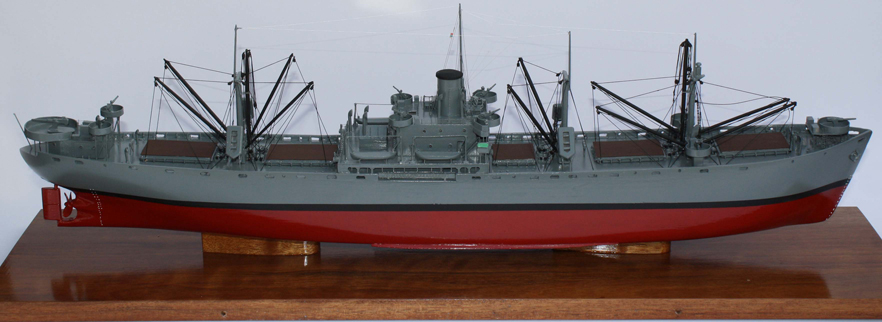Liberty Ship, US Emergency Construction Cargo Ship (1941)
Particulars
Vessel type: General Cargo Vessel type EC2-S-C1
Designer: US Maritime Commission, as a modification of a simple WWI era design.
Builder: 18 shipyards in the United States. Total built: 2,751
Keel Laid: 1941 (first hull) 1945 (last hull)
Date Delivered: 1941 (first hull) 1945 (last hull)
Date Modified: Never really as a design except to install a riveted crack arrester. But hundreds of liberty ships were modified for all types of commercial purposes after WWII.
Date Scrapped: Three Liberty ships survive as museum vessels.
Length on deck: 441.5 feet
Length over all: 441.5 feet
Beam: 56 feet 10.75 inches
Depth: N/A
Draft: 27 feet 9.25 inches
Gross Tonnage:
Lightweight Tonnage: 14,245 minus 10,685
Maximum Displacement: 14,245 long tons
Construction Material: Welded mild steel
Rig Type: Rigged with cargo booms
Crew Size: 41
Passenger Capacity: None
Propulsion Plant: Single screw oil fired steam using two boilers and a triple expansion steam engine
Horsepower: 2500
Cruising Speed: 11 knots
Maximum Speed: 11.5 knots
Armament: Normally a 4 inch stern mounted gun for antisubmarine purposes plus various anti air guns
Vessel Description
The Liberty ship class was a rapid answer to a vital need. In the early stages of World War II the loss of commercial shipping to U-boats was so high there was serious concern the allies would lose the war due to their inability to get supplies to the European Theater. The US Maritime Commission, tasked with speeding up ship construction in the United States, decided to no longer rely on their standard (and rather fancy) designs and instead developed a design (partially based on a WWI design) that while not particularly fast could be built quickly and did not rely on strategic technologies and equipment. This led to the decision to power the vessels with triple expansion steam engines rather than steam turbine or diesel engines. It was also decided that the vessels should be welded rather than riveted even though the United States had a much larger shipbuilding base that could rivet ships rather than weld ships. It was decided that welding could be taught quickly and particularly women could be trained to weld ships. The Liberty ship also was the first ship class where modular construction would be exploited to the maximum extent. The result was a vessel that could be built in weeks. There is a four day record, but more accurately that was the component assembly time rather than the built time and a more realistic build time was a few months.
A total of 2751 Liberty ships were built during the war and, incredibly, more than 2,400 survived the war.
Vessel History
This particular model is a standard Liberty ship and therefore it does not represent a particular ship with a particular history. Some Liberty ships were lost on their first voyage while other Liberty ships are still operational as museum ships. The John Brown and the Jeremiah O’Brien remain as operating Liberty ships and occasionally leave their berths under own power.
Technical Model Description
This model was built by Henry Schaefer in 1965 from a Bluejacket kit. This kit continues to be available and is a good example of a sophisticated model but that can be built by somebody with limited model building experience. It is very carefully executed with excellent detailing.

